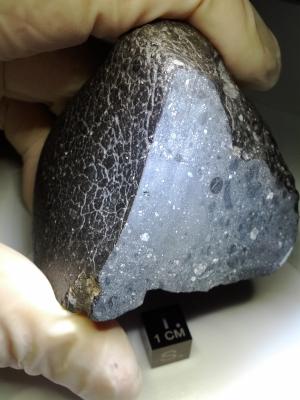Post
A Rusted Development
2 July 2013
Of the tens of thousands of meteorites that have been discovered on Earth, about a hundred came from Mars, such as the one pictured below. We know they originated from Mars because their composition is different from other meteorites, and they correlate with the atmospheric and geological composition of Mars as determined by the Martian landers. They are currently the only martian material to which we have direct access.
 NASA
NASAThese meteorites were blasted from Mars when comets or asteroids collided with Mars, sending fragments out into space. Eventually their orbits intersected with Earth. The martian meteorites don’t originate from a single event, but rather from various events throughout martian history. As a result these meteorites provide clues to the geological evolution of Mars. The downside is that most of these meteorites originate from the more recent period of Mars, from about 1.5 billion to 800 million years ago, so they don’t provide any clues about the earliest period of martian history.
For that we have to look at data from the martian landers. Specifically, the Spirit rover, which examined Gusev crater. The surface of Gusev crater dates to about 3.8 billion years ago, so Spirit’s analysis of Gusev rocks allows us to compare the early period of Mars with more recent periods. The results were published this week in Nature1 has led to the conclusion that Mars had an oxygen rich atmosphere in its youth.
The team analyzed the concentration of nickel in both the meteorites and the Gusev rocks. What they found was the Gusev rocks were significantly higher in nickel than the meteorites. The reason why this is important is that in an oxygen free environment nickel tends to react with sulfur, leading to lower concentrations in the meteorites. In an environment with free oxygen, the sulphur reacts with the oxygen, making it less available to nickel. As a result rocks that form in an oxygen rich environment have higher concentrations of nickel. Therefore the Gusev rocks formed in an oxygen rich environment.
This finding is significant because it means that Mars had a wet environment with an oxygen rich atmosphere four billion years ago. Over time the water and oxygen reacted with surface rocks of Mars, leading to the rusty surface it has today. This is quite different from Earth’s geological history, where free oxygen only appeared in our atmosphere about 2.4 billion years ago.
Of course news of a wet young Mars with an oxygen atmosphere has lead many articles to write about evidence of life on Mars. On Earth the presence of free oxygen in our atmosphere was caused by the presence of life. Specifically, cyanobacteria produced (and still do produce) free oxygen as a waste product. This early oxygen first reacted with surface rocks and atmospheric gases until they became saturated. Only then did free oxygen appear in our atmosphere.
But on Earth this had serious consequences. The presence of oxygen is toxic to many anaerobic life forms, so there may have been a mass extinction of such organisms. The free oxygen also reacted with greenhouse gasses in the atmosphere, leading to a snowball Earth period that nearly wiped out life on our planet. Only later did oxygen-using organisms evolve. Since oxygen is highly reactive, it’s not clear that life could begin in an oxygen-rich environment. Such an early oxygen atmosphere may in fact be evidence against life on Mars.
It may be that the presence of oxygen may have arrested the development of life in the first place.
Tuff, J., J. Wade, and B. J. Wood. “Volcanism on Mars controlled by early oxidation of the upper mantle.” Nature 498.7454 (2013): 342-345. ↩︎